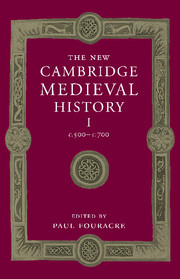Book contents
- Frontmatter
- Introduction: the history of Europe 500–700
- 1 The later Roman Empire
- 2 The Barbarian invasions
- 3 The sources and their interpretation
- PART I THE SIXTH CENTURY
- PART II THE SEVENTH CENTURY
- 11 The Byzantine empire in the seventh century
- 12 Muhammad and the rise of Islam
- 13 The Catholic Visigothic kingdom
- 14 Francia in the seventh century
- 15 Religion and society in Ireland
- 16 Christianity amongst the Britons, Dalriadan Irish and Picts
- 17 England in the seventh century
- 18 Scandinavia
- 19 The Slavs
- PART III THEMES AND PROBLEMS
- List of Primary sources
- Bibliography of secondary works arranged by chapter
- Index
- Frontispiece"
- Plate section"
- Map 3 Gaul/Francia in the sixth and seventh centuries"
- References
13 - The Catholic Visigothic kingdom
from PART II - THE SEVENTH CENTURY
Published online by Cambridge University Press: 28 March 2008
- Frontmatter
- Introduction: the history of Europe 500–700
- 1 The later Roman Empire
- 2 The Barbarian invasions
- 3 The sources and their interpretation
- PART I THE SIXTH CENTURY
- PART II THE SEVENTH CENTURY
- 11 The Byzantine empire in the seventh century
- 12 Muhammad and the rise of Islam
- 13 The Catholic Visigothic kingdom
- 14 Francia in the seventh century
- 15 Religion and society in Ireland
- 16 Christianity amongst the Britons, Dalriadan Irish and Picts
- 17 England in the seventh century
- 18 Scandinavia
- 19 The Slavs
- PART III THEMES AND PROBLEMS
- List of Primary sources
- Bibliography of secondary works arranged by chapter
- Index
- Frontispiece"
- Plate section"
- Map 3 Gaul/Francia in the sixth and seventh centuries"
- References
Summary
With the abandonment of Arianism at the Third Council of Toledo in 589, there began a new phase in the evolution of the Visigothic kingdom. Religious unification facilitated the definitive rapprochement of the Gothic nobility and upper classes of Roman origin, and allowed the Catholic church, the principal repository of the old Roman culture, to acquire a growing prominence in the political life of the kingdom. This active political role was expressed principally through the series of national church councils in Toledo, the regal metropolis, initiated by that of 589. In these the church seemed to play the role of arbiter between the royal power and the high nobility, although a close reading of the conciliar acts reveals its tendency to act in solidarity with the secular nobility. Kings, on the other hand, only exceptionally made use of the councils in order to assert their authority and were generally obliged to negotiate in the face of the powerful secular nobility and church, this being one of the main causes of the weakness of centralised authority. Religious unification also made way for a progressive interpenetration of the spiritual and temporal spheres at every level of Visigothic life and society, in which the former shaped the whole dominant ideological structure.
religious unification
In the spring of 586 King Leovigild (568–586) was succeeded by his son Reccared, who had for years been associated with the throne: according to the chronicler John of Biclaro, the succession took place without difficulties. In the first year of his reign the new king sought an alliance with Gosuintha, his father’s widow, whom he adopted as his mother, and tried to broker a peace with the Frankish king, although Guntramn of Burgundy continued to maintain the bellicose tension along the Narbonensis frontier, which had been a feature of Leovigild’s reign.
Keywords
- Type
- Chapter
- Information
- The New Cambridge Medieval History , pp. 346 - 370Publisher: Cambridge University PressPrint publication year: 2005
References
- 2
- Cited by



